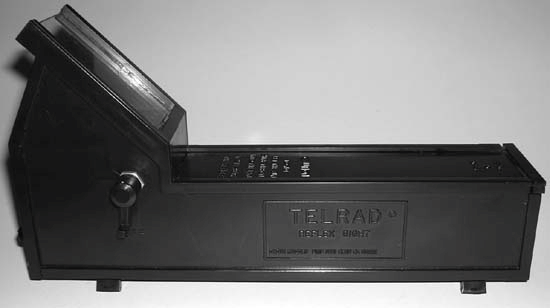Hack20.Locate Objects Geometrically
Hack 20. Locate Objects Geometrically
You can find things quickly by reckoning from the easy-to-find objects, imagining some lines between them, and going in for the kill with a bulls-eye finder. The human eye and brain are superbly evolved for detecting patterns. We see lines, angles, and patterns even where none exist, particularly when we look at bright stars against the velvety black background of the night sky. You can take advantage of this by creating imaginary lines and patterns on the celestial sphere, and using those lines and patterns to locate objects geometrically. Geometric navigation allows you to jump directly to objects in seconds rather than spend minutes tracking them down by following a path of dim stars. A unit-power finder [Hack #53] like the Telrad (shown in Figure 2-15) is an essential aid to geometric navigation. The Telrad works like the heads-up gunsights in WWII fighter planes. When you look through the Telrad, you see a dim, red bulls-eye target against the background sky. The Telrad circles are 0.5°, 2°, and 4°, which means you can use a Telrad to locate almost instantly any object within 4° of a bright star or other easily identifiable object. Figure 2-15. The Telrad unit-power finder For example, let's say you want to locate Messier Object 79 (M79), a globular cluster in the constellation Lepus, shown in Figure 2-16. You could track it down the hard way, by star hopping [Hack #21] from the star 9 b-Leporis (Nihal), following a trail of dim stars (not shown in the graphic) in your optical finder until you eventually end up with M79 in your eyepiece. Although doing it that way might give you a sense of accomplishment, it might also take 5 or 10 minutes that could be better spent looking at the object. Figure 2-16. Locating Messier 79 with a Telrad To locate M79 with the Telrad, start with the triangle formed by the three naked-eye stars 9 Bet Lep (Nihal), 13 Gam Lep, and 2 Eps Lep, shown in Figure 2-16. Draw an imaginary baseline from 13 Gam Lep to 2 Eps Lep. Place the outer ring of the Telrad so that it just touches your imaginary baseline about halfway between the two guidepost stars. To confirm the position, use another geometric relationship. Note that the center of the Telrad pattern should be just slightly to the 13 Eps Lep side of the line from 11 Alp Lep (Arneb) to 9 Bet Lep (Nihal). M79 should be visible in your low-power eyepiece. Total time to locate the object? Five seconds or so. The Telrad is useful for locating any deep-sky object other than those located far from any naked-eye stars, but some objects are easier than others. For example, Figure 2-17 shows how we use the Telrad to locate four galaxies in Ursa Major without using star hops. Figure 2-17. Locating Ursa Major galaxies geometrically Although it is located more than 5° from each of the two nearest bright stars, Alkaid and Mizar in the Big Dipper's handle, M101 is an easy find with the Telrad if you use geometric navigation. Simply create an imaginary equilateral triangle with Alkaid and Mizar as two of the apices. M101 is located at the third apex of the triangle. You can have M101 in your eyepiece in literally five seconds, while the folks with go-to scopes are still waiting for them to grind their way to the target. M51, the famous Whirlpool Galaxy, is just as easy with the Telrad. Imagine a line from Alkaid to Mizar as the base of a right triangle. From that base, drop an imaginary perpendicular line. Put the Telrad on that line, with the outer circle about 1.6° from Alkaid. Here's where the known sizes of the Telrad circles come in handy. You need 1.6°, and you know that the distance from the outer 4° Telrad circle to the inner 0.5° circle is 1.75°. You can simply eyeball the approximate offset and put the Telrad about where you think it needs to be. Bump the scope just a tiny bit off the perpendicular, away from the Big Dipper's bowl, and M51 is in your eyepiece. Total time required? Five seconds. The Telrad can be useful even if the object you are trying to locate is more distant from bright stars. For example, the bright galaxy pair M81/82 is located more than 10° from Dubhe. But note the line from Phad to Dubhe. As it happens, the distance from Phad to Dubhe (about 10.5°) is almost identical to the distance from Dubhe to M81/M82 (about 10.1°), and M81/ M82 is very close to that line. It's easy to place the Telrad geometrically to put M81/M82 into the field of view of a 50mm finder, in which they are weakly visible. Once again, it takes a Telrad user five seconds to locate an object that takes much longer to find by star hopping or using a go-to scope. Even when you can't locate an object directly with a Telrad, it remains useful. For example, if you are trying to locate an object that is far from any bright naked-eye stars and for which no convenient geometric relationship exists, you can still use the Telrad to shorten the required star hop, sometimes dramatically. Rather than do a full star hop from the nearest bright star, which may be quite far away, you can use the Telrad to put your optical finder at a closer starting point for which a geometric relationship does exist. Examine your charts to locate a distinctive pattern of stars that will be bright in your optical finder5th and 6th magnitudeand then put the Telrad where that pattern should be. Once you are sure you have that pattern in your optical finder, you can use it as a departure point for your star hop to the object.
|
EAN: 2147483647
Pages: 112
